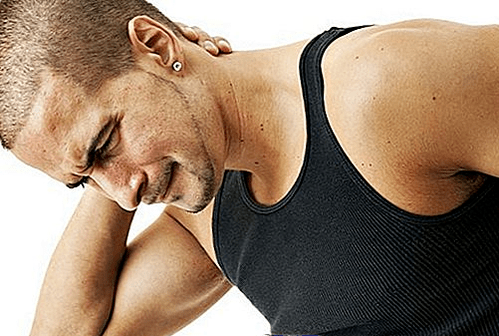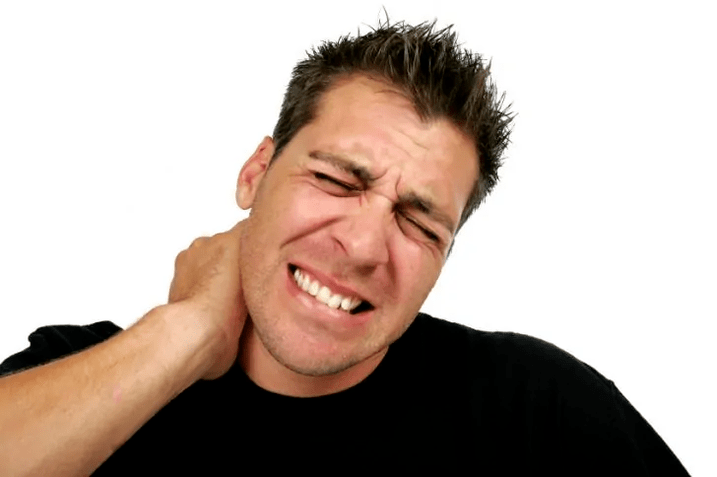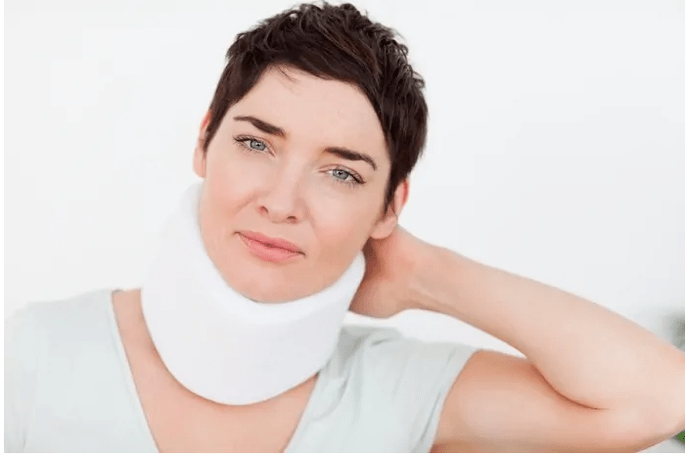Osteocondrosis is often observed in the cervical column, due to the anatomical characteristics of the structures of this department. First of all, the cervical vertebrae are very closely between them. And secondly, the muscle frame of the neck is poorly developed. It is for these reasons that the cervical vertebrae and the compression of the nerve roots, the blood vessels are so easily the lower cervical vertebrae are more often affected than the upper ones.

Cytimomes of cervical osteochondosis
The clinical symptoms of cervical osteochondrosis are extremely different. Many people do not even suggest all types of symptoms (pain in their hands, dizziness, etc. ), can be associated with the neck pathology. In general, all symptoms that occur with cervical osteochondrosis can be considered in three syndromes:
- Compression brown syndromes;
- Irritative reflection syndromes;
- Vail artery syndrome.
Compression crust syndromes
Against the background of the cervical osteochondrosis, intervertebral and osteophytes can form. These structures compress the nerve roots, which lead to the occurrence of the symptoms of the radicalitis. The compression of each vertebral column is associated with specific reflections, engines, sensitive:
- When the spine of C1 occurs, pain occurs, as well as compromised sensitivity (decrease in sensitivity, numbness, tingling skin, feeling of geutine) in the parietal area;
- When the vertebral column of C2 compresses, the pain develops, as well as a change of sensitivity in the parietal and consumer head area;
- When the dorsal plug of C3 compresses, the pain is noticed, as well as a change of sensitivity in the neck. In addition, a person can be disturbed by the feeling of swelling of the language on the one hand, by the difficulties of difficulty of the language and by the compromise of language.
- When the S4 vertebral column compresses, the pains are noted, as well as a change of sensitivity in the clavicle. Icote, dysphonia can occur. Since the fibers of the diaphragmatic nerve pass into the spine, with the compression of the spine, breathing, pain in the heart can occur.
- When the spine of C5 compresses, the shoulder pain is developed, as well as a change in the sensitivity of the skin on the external surface of the shoulder.
- When the span of C6 compresses, the pain spreads from the neck to the scapula, as well as the external surface of the shoulder, the forearm and the thumb of the brush. There is a violation of the sensitivity of the skin in this area. The two debts muscle is exaggerated, the reflection is reduced.
- When the vertebral column of C7 compresses, the pain from the neck spreads under the scapula, on the external surface of the shoulder, the forearm and the fingers II -II of the hand. There is a violation of the sensitivity of the skin in this area. The three -headed muscle is exaggerated, the reflection is reduced.
- When the spine of C8 compresses, the pain from the neck spreads on the hand to the little finger. The sensitivity of the skin in this area is disturbed. Hypotrophy and a decrease in the reflection from the three -headed muscle occur.
For root syndrome, acute pain and its strengthening when moving the head are characteristic.
Irflex irritation syndromes
The early stages of osteochondrosis are characterized by the occurrence of reflected syndromes. With cervical osteochondrosis, the following options for reflected syndromes can occur:
- Cervicalgia is an intense painful pain in the neck, which is as expressed as possible after waking up in the morning, as well as when you turn your head, cough and even laughter.
- Cervicobrachialgia - Pain is concentrated in the neck and neck.
- Cervicobrachialgia - neck pain, shoulder and forearm.
A cervicobrakalgia can occur with muscle-symptic, vegetative-vascular and neurodieric manifestations. Muscle tonic syndromes are the result of reflected muscle spasm. The following muscle-syndonic syndromes are distinguished:
- The lower oblique muscle syndrome - manifests itself from constant painful pain in the neck and the back of the head on the one hand, which intensifies itself significantly during the curves of the head;
- The reflective syndrome with shovel occurs with painful pain in the neck and upper corner of the scapula and in the shoulder or even in the lateral surface of the chest. A feature feature is an increase in pain during the pronation of the brush open from the lower back.
Neurodystrophic syndromes include periartrosis full of shoulder, short -term shoulder, shoulder syndrome. Periarthrosi shoulder -Shoulder - characterized by pain in the shoulder joint, which intensifies during the shoulder movements or raising the hand. The pain can radiate towards the arm, the neck. The skin in the shoulder joint is swollen. For shoulder syndrome, the presence of signs of a Periartroz spreads in a combination with vegetative-vascular changes and trophies in the crashing of the wrist and the brush is characteristic. The skin of the brush becomes edematous, its changes in color, the local temperature increases. Epicondiles' shoulder is a neuroding change in the shoulder, instead of the attachment of many muscles. It manifests itself from painful and constant pains in the auction area, which intensify in the implementation of brusque movements on the elbow or brush.

Vail artery syndrome
The vertebral artery takes place in the canal formed by the processes of the cervical vertebrae. The vase provides the flow of blood to many brain structures. The narrowing of the ship is possible both because of its reflex spasm and mechanical compression. When it narrows the ship, the vertebral artery syndrome is formed, which are characterized by the following symptoms:
- Cranially: painful headache, constant more often a member, considerably intensified with the movements of the head. Pain spreads from the back of the forehead.
- The pain of the scalp, determined with the light touch even when she combed her hair.
- Violations of Kohletovestilarnnyi: they are manifested by dizziness, tinnitus (ringing in the ears), a decrease to a light extent and a violation of balance.
- Visual disorders: dark and trembling flies in front of my eyes.
- Neurasthenic syndrome: irritability, emotional lability, sleep disorders.
- Vegetative symptoms: heat, chills, cooling of the hands.
- Fluctuations in blood pressure.
- With the compression of the vertebral artery caused by a strong turn of the head, a person can lose knowledge. This option is also possible: a person falls as if he were triggered, but at the same time he is conscious. This violation is called Fall attacks.
Treatment of cervical osteochondosis
It is very difficult to fight osteochondrosis in an advanced form. Various medicines are used to eliminate the symptoms of the disease. A no less significant role is played by therapeutic gymnastics, as well as physiotherapy, massage. In some cases, wearing a special collar is very useful. Popular remedies will help to integrate the treatment.
Wear a cervical collar
Wearing a collar helps to relieve muscle tension from the neck and also gives the correct position to the spine, thus eliminating the compression of the vertebral artery and nerve roots. Cervical collars are rigid (Shanta) and inflatable collar. The Shanz collar is a dense frame that is fixed on the neck. He takes the whole gravity of his head, thus relaxing the tense muscles of the neck. Inflatable collars are a device that must be put on the neck and therefore with the help of a connected pear, pump air. The swollen collar pulls the spine. The collar is not worn all day, but a few hours a day. On average, the length of wearing the device is one month. Note: The need to use the collar is determined by the doctor. In no case do not put it alone without a prescription. In some cases, the collar can prevent the vessels and nerves, which can cause serious consequences.
Exercises for cervical osteochondosis

Therapeutic gymnastics is recommended for all patients with osteochondrosis in the absence of contraindications. The performance of physical exercises during the exacerbations of the disease are contraindicated. Therapeutic gymnastics can be done after pain mitigates. The regular performance of the exercises allow to strengthen the muscle frame and reduce the load on the intervertebral discs. Regular physical activity contributes to the improvement of blood intake in the neck and, due to the normalization of metabolic processes that occur in the intervertebral discs. An approximate set of exercises for cervical osteochondosis:
- Sit on a chair. Turn your head to the right and left.
- Take your head downwards, touching the seizure of the chest.
- Pull the neck back, while drawing a chin.
- Put the palm on the forehead and reward it, while it is important to tilt your head forward, resisting.
- The palm must alternately be applied to temples and absolutely as in the previous year to resist the movement of the head with one hand.
- He raises his shoulders as much as possible, counts up to ten. Then lower your shoulders and relax. After ten seconds, do the same manipulation.
All exercises must be repeated ten times.


























